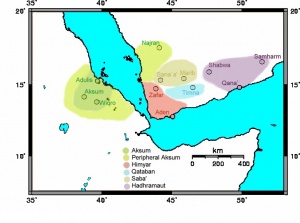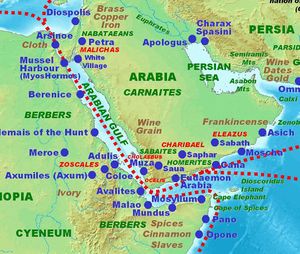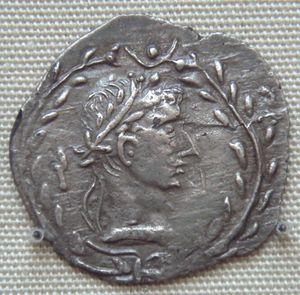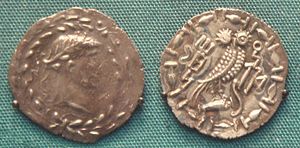Saba and Himyar
Himyar and Ethiopia. Another Jewish state, in a different part of the Diaspora, was founded at about the same time as the principality of Cranganor: the Jewish kingdom of Himyar, the present Yemen. From the Book of Himyar, as well as from recently deciphered inscriptions, we gather that Judaism had spread to Yemen as early as the third century C.E., possibly even earlier. Confirmation of this view comes from the sarcophagi of Himyar princes -- Jews or judaized natives -- that were discovered in the tombs recently excavated in Beit She'arim. More is known to us of the Himyar kings who were known as Tuba'a and who fought for the independence of their country against the Christian Ethiopian invaders of the House of Aksum.
Those Tuba'as reigned for a period of one century from the end of the fourth onwards. Jewish or judaized kings are known to us:
- Jasirum Juhani'm or Yassirum Yohre'am, king of Sheba and Dhu Raidan, embraced the Jewish faith in 270 C.E.
- His son Shamar Juharish, king of Sheba and Dhu Raidan, Hadramaut and Jomanat, reigned 281-300.2
- Hassan Tub'a, a descendant of 2, fought against Constantine.
- 'Amr-Shlomo, 325-330, was a Jew, the son of David and grandson of As'ad I; he was orphaned of his father and himself died young.
- His widow, Belkis or Makkedah, daughter of Kudkud Had had, prince of Tuhama or Hamdan. Kudkud was the founder of the new dynasty of the Abu Karibas. Juha'min Malki Kariba was therefore Makkedah's brother.
- Malki Kariba Juha'min 378-385 C.E., the first judaized king of the Kariba dynasty, and his descendants (7, 8, 9).
- Abu Kariba As'ad, or As'ad Kariba, the second judaized king, 390-420 C.E.
Contents
Saba
Sheba (from the English transcription of the Hebrew language name sh'va and Saba, Arabic language: سبأ, also Saba, Amharic language: ሳባ, Tigrinya language: ሳባ) was a southern kingdom mentioned in the Tanakh (Old Testament) and the Qur'an. The actual location of the historical kingdom is disputed between southern Arabia and Ethiopia; the kingdom may have been situated in either present-day Ethiopia or present-day Yemen.
The nation makes its first appearance in world literature with the mention of the Queen of Sheba (named Makeda in Ethiopian tradition and Bilqis in Islamic tradition), who travels to Jerusalem to behold the fame of King Solomon (1 Kings 10). The location of Sheba has thus become closely linked with national prestige, as various royal houses have claimed descent from the Queen of Sheba and Solomon. Sheba is also mentioned in other biblical texts. For instance, in the Old Testament genealogy of the nations Genesis 10:7, Sheba, along with Dedan, is listed as one of the descendants of Noah's son Ham, son of Noah (as son of Raamah, son of Cush, son of Ham). In Genesis 25:3, Sheba and Dedan are listed as sons of Jokshan. Another Sheba is listed in the genealogy appearing in Genesis 10 as a descendant of Noah's son Shem: that is, as a Semite (this genealogy lists Sheba as a son of Joktan, son of Eber, son of Shelah, son of Arphaxad, son of Shem.) However, these accounts are of little historical value as they merely represent the ahistorical beliefs of ancients writers who had minimal contact with the actual historical kingdom of Sheba.
Long the most vigorous claimant has been Ethiopia and Eritrea, where Sheba was traditionally linked with the ancient Axumite Kingdom. As Ethiopia has remained a Christian state, the connection to Sheba has been an important one, especially to the former ruling family, the Solomonic dynasty.
The Qur'anic Queen of Sheba, Bilqis, was a ruler who visited Solomon after receiving a letter from him inviting her to submit to God. The letter read, "In the Name of Allah, the Most Beneficent, and Most Merciful: be you not exalted against me, but come to me as Muslims (true believers who submit with full submission)" (27:30-31 Quran). After visiting with King Solomon the Queen of Sheba said, "My Lord! Verily, I have wronged myself, and I submit (in Islam), together with Sulayman, to Allah, the Lord of the Alamin (mankind, jinns, and all that exists)" (27:20-44 Quran).
Evidence is mounting of a region in northern Tigray and Eritrea which called itself Saba. As yet, most scholars would call it Ethiopian Saba, and indicate that it supports the assumption that Sabean culture existed both in Ethiopia and Yemen, without one colonizing the other.
Nevertheless, recent archaeological evidence has not supported the Ethiopian claim stronglyTemplate:Fact. Most scholars today believe that, at most, the kingdom of Sheba controlled some coastal regions of Ethiopia and Eritrea but was centered on the southwestern tip of the Arabian peninsula, modern Yemen. Linguistic evidence also points to a close historical relationship between the two sides of the Red Sea, as South Semitic languages are found only in two places: southern Arabia (modern Yemen and Oman), and the Horn of Africa (modern Eritrea and Ethiopia). Additionally, the modern Ge'ez alphabet developed from the old South Arabian alphabet.
Modern scholars tend to think a link to the Sabaeans of southern Arabia, who inhabited the same region, is the most probable. However, Ethiopist Donald Levine argued in favor of one Ethiopian tradition that "Sheba is Shewa!"
Ruins in many other countries, including Ethiopia, Somalia, Yemen, Sudan, Egypt, Eritrea, and Iran, have been credited as being Sheba, but with only minimal evidence. There has even been a suggestion of a link between the name "Sheba" and that of Zanzibar.
According to Marco Polo, Saba is the location of the tombs of the three Magi.
Himyar
The Himyarite Kingdom or Himyar (in Arabic حِمير), anciently called Homerite Kingdom by the Greeks and the Romans, was a state in ancient South Arabia dating from 110 BCE. It conquered neighbouring Sheba in 25 BCE, Qataban in c.200 CE and Hadramaut c.300 CE. Its political fortunes relative to Sheba changed frequently until it finally conquered the Sabaean Kingdom around 280 CE.[1]
History
It was the dominant state in Arabia until 525 CE. The economy was based on agriculture. Foreign trade was based on the export of frankincense and myrrh. For many years it was also the major intermediary linking East Africa and the Mediterranean world. This trade largely consisted of exporting ivory from Africa to be sold in the Roman Empire. Ships from Himyar regularly traveled the East African coast, and the state also exerted a considerable amount of political control of the trading cities of East Africa. The Periplus of the Erythraean Sea describes the trading empire of Himyar and its ruler Charibael (Karab Il Watar Yuhan'em II), who is said to have been on friendly terms with Rome:
- "23. And after nine days more there is Saphar, the metropolis, in which lives Charibael, lawful king of two tribes, the Homerites and those living next to them, called the Sabaites; through continual embassies and gifts, he is a friend of the Emperors."|Periplus of the Erythraean Sea, Paragraph 23.[2]
The last sovereign Tubba Himyarite king, (Arabic: ذو نواس Dhu Nuwas) is often considered to have converted to Judaism. His war against the Ethiopian Aksumite Christians in his kingdom, resulted in a famous massacre in Najran. Other Ethiopian and Himyarite Christians at Zafar were massacred. Emperor Justinian informed Kings of Axum Kaleb of Axum of the Ethiopian Kingdom of Aksum about Dhu Nuwas's actions, encouraging him to intervene. Around 525, Kaleb invaded Himyar and defeated the Jewish King, but his first viceroy was later removed by Abraha, an Aksumite General. Abraha later recognized Aksum's dominion over him and continued to rule Himyar until 570 CE. A coalition of History of Yemen and Sassanid dynasty later replaced Kingdom of Aksum governance with a Sassanid dynasty one. In 632 CE Himyar was absorbed into the Islamic empire.
The Himyarite language was spoken in the south-western Arabian peninsula until the 10th century.
Rulers of Sheba
The following are the two alternative listings of the Rulers of the Yemeni kingdom of Sheba.
Version 1
- Samahu 'Ali ca. 750 BC
- Yada'-il Dharih ?
- Yathi'-amar Watar I ?
- Yada'-il Bayin I ?
- Yathi'-amar Watar II ?
- Kariba-il Bayin ?
- Dhamar 'Ali Watar ?
- Samahu 'Ali Yanif I ?
- Yathi'-amar Bayin I ?
- Kariba-il Watar I ca. 450 BC
- Samahu 'Ali Darih ?
- Kariba-il Watar II ?
- Il-Sharah I ?
- Yada ?
- Yakrib ?
- Yathi' ?
- Karib-il ?
- Samah ?
- Il-Sharah II ?
- Dhamar ?
- Yada' ?
- Dhamar ?
- Karib-il Watar IV ?
- Il-Karib Yuhan'im ?
- Karib-il Watar V ?
- Wahb-il ?
- Anmar Yuhan'im ?
- Dhamar 'Ali Darih ?
- Nash'a-Karib Yuhamin ?
- Nasir Yuhan'im ?
- Wahb-il Yahuz ?
- Karib-il Watar Yuhan'im ?
- Yarim Ayman I ca. 80-ca. 60 BC
- 'Alhan Nahfan ca. 60- ? BC
- Far'um Yanhab ?
- Yarim Ayman II ca. 35-ca. 25 BC
- Sha'irum Awtar ca. 25 BC- ? with:
- Yazil Bayin ca. 25 BCE- ? and with:
- Ilasharah Yahdub ca. 25 BCE- ? (reigned after the demise of both Yazil Bayin and Sha'irum Awtar)
- Sheba to Himyar thereafter
Version 2
(High Priests) Mukkaribs of the Sabians
- 1200-800 BCE
- unknown
Mukkaribs of Saba
- Yada’il Yanif ben Kariba-il ca. 755-ca. 740 BC
- Samahu 'Ali Darih I ben Yada’il Yanuf ca. 740-715 BC
- Yathi'-amar Bayin I after 715 BC
- Dhamar 'Ali I after 715-before ca. 685 BC
- Kariba-il Watar I ca.685-ca.675 BC
- Samahu’Ali I after 675 BC
- Yada’il Darih I ?
- Samahu 'Ali Yanuf I ?
- Darih ?
- Yathi'-amar Watar ?
- Yada’il Bayin I ?
- Karib-il Bayin I ?
- Dhamar 'Ali Watar ?
- Samahu’Ali Yanuf II ca. 545-ca. 525 BC
Kings of Saba
- Styled Malik
- Yathi’-amar Bayin II ca. 525-ca. 495 BC
- Kariba-il I after 495 BC
- Yada’il I ? and:
- Yathi’-amar I
- Kariba-il II
- Samahu’Ali II
- Yada'il II
- Yathi’amar II
- Yada’il Bayin II
- Samahu’Ali Yanuf III ca. 410-ca. 380 BC and:
- Yathi’-amar Watar I
- Yaqrub Malik Darih ?
- Samahu’Ali Yanuf IV ?
- Yada’il Bayin III ?
- Yaqrub Malik Watar I ?
- Yathi’-amar Bayin III before 320 BC
- Karib-il Watar II ca. 320-ca. 270 BC
- Yada’il Bayin IV after 270 BC
- Yaqrub Malik Watar II ?
- Dhamar’Ali Yanuf ?
- Yathi’-amar Bayin IV before ca. 200 BC
- Samahu’Ali Darih II ca. 200-ca. 175 BC
- Karib-il Bayin II
- Yathi’-amar III before ca. 140 BC
- ??? ca. 140-ca. 116 BC
- Under Himyar 116-55 BC
- Samahu’Ali Yanuf V ca. 55 BC
- Yada’il Watar I ca. 30 BC
- Dhamar’Ali Bayin I ca. 25 BC
- Yadail Darih II ca. 10 BC-ca. 10 CE
- Yathi’-amar Watar II ca. 10-20 CE
- Yada’il Watar II ca. 20-30 CE
- Dhamar 'Ali Bayin II ca. 30-60 CE
- Karib-il Watar Yuhan'im ca. 60-75 CE
- Dhamar’Ali Darih ca. 75-85 CE
- Ilasharah Yahdub ca. 85-100 CE
- Most parts to Himyar thereafter
Gurat and Marib
These two nations were the remnants of Sheba and both fell to Himyar in the 3th Century
Gurat
- Nash'a-Karib Yahamin ben Dhamar’Ali Bayin II ca. 85-ca. 100 CE
- Sa'd Shams Asra ben Ilsharah Yahdub ca. 100-ca. 130 CE
- Murtaza Yuham'in ca. 130-ca. 160
- ??? 160-180
- Farim Yanhub ca. 180-ca. 200
- Ilsharah Yahdub II ca. 200-ca. 230
- Nash'a-Karib Yamin ca. 230-ca. 250
- To Himyar thereafter
Marib
- Kurb ail Watur ibn Thamar ibn Ali 4th Century BC
- Yas'a 4th Century BC
- ??? 4th Century BC-ca.100 CE
- Bahab’il Yahuz ca. 100-ca. 130 CE
- Anmar Yuhamin ca. 130-ca. 140 CE
- Kariba-il Watar Yuham’in after ca. 140 CE
- Rabb Shams Nimran after ca. 140 CE-before ca.190 ce
- Sahr Autar ca. 190-ca. 200
- Lahay’atat Yarham ca. 200
- To Himyar thereafter
Rulers of Sheba and Himyar
| Mukribs of Saba' | |
| 1 | Yatha' Amar Bayin I | </td>



